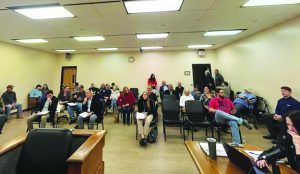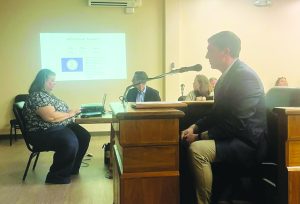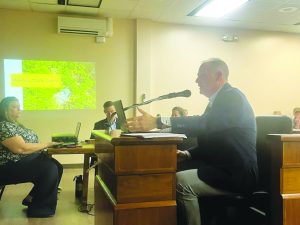In a 3-1 vote last week, the Patrick County Board of Supervisors tabled a vote on the proposed Patrick County High School (PCHS) Cellular Phone Tower until its May 13 meeting.
Before that, the board heard from representatives of Milestone Towers, the applicant and developer of the project, including Director of Development Matthew Penning and License Professional Engineer Andrew Peterson.

Penning said Milestone, a Virginia-based business, has been in business for over 20 years with over 150 towers constructed.
“It always starts for us on the need for a site. Our company policy is never to build a speculative site, we already have a signed lease with Verizon for a tower at Patrick County High School, so Verizon would be the first tenant to come on the tower,” he said.
The tower would be built for up to four wireless carriers, according to Penning, who said with the tower, Verizon is trying to address the coverage deficiency it has in the area and its capacity.
“They add another site into their cellular network which opens up and creates more capacity. So, obviously for a high user area like Patrick County High School, which has 1,000 staff and students approximately, the surrounding area has over 100 households and then 4,300 average daily travelers along Route 8,” he said.
Penning said the proposed tower would add to the area’s coverage and offload capacity on the existing sites to improve and enhance connectivity in the area. Milestone has worked with the school board to site the tower on the northwestern side of the 67-acre property.
“This gives it over 1,200 feet from the closest residence as well as 1,700 feet from Route 8 and Salem Highway. The large school parcel allows us to site it in a way that screens it from surrounding residences and from the roadways,” he said.
Penning said the total footprint for the tower compound site will be less than 2,500 square feet, “which is less than a 50 by 50 square compound. It will be enclosed by an eight-foot-tall fence with privacy slates, and we’re going to be utilizing the existing access road.”

The tower structure will be near the existing pole yard that is used by Patrick & Henry Community College (P&HCC).
Peterson said the Federal Communications Commission (FCC) has the sole jurisdiction over the regulations regarding electromagnetic field safety.
“Basically, the FCC’s guidance is codified in the Code of Federal Regulations, and that is the law of the land when it comes to electromagnetic safety,” he said.
As tower developers and wireless providers, Peterson said Milestone is required to demonstrate compliance with the FCC guidelines.
When a new facility is being built, he noted the company cannot measure it because it’s not yet on the air.
“So, what we do, and what has been deemed appropriate as the method of demonstrating compliance is, we perform calculations to determine what the anticipated exposure levels would be from a facility once it’s on the air,” he said.
Peterson said companies accomplish this by using the formulas prescribed by the FCC.
“Because we use multiple factors, upper limit factors, we’re really looking at a worst-case scenario for the maximum exposure on ground level, and that’s what we’ve done here,” he said.
In this case, Peterson said he wrote a report demonstrating that the proposed facility would be less than 1.4 percent of the applicable FCC standards at all locations of public access.
“Often, I get the question, ‘Well what if there are more carriers that jump on board- AT&T, T-Mobile, Dish Network.’ There’s really only four in the marketplace at the moment,” he said. “So, we go a step further and evaluate the anticipated exposure with all of the carriers in the marketplace onboard.”
Peterson said the calculations show that even with worst-case assumptions of all four carriers, it would still be below 8 percent of the applicable FCC standards, which is “still compliant by a wide margin.”
The FCC exposure limits are based on recommendations made by organizations including the Occupational Safety and Health Administration (OSHA), the American National Standards Institute (ANSI), and the National Council on Radiation Protection and Measurements (NCRP), Peterson said.

After construction, Peterson added Milestone always has a third party verify that the anticipated exposure levels that were calculated are what’s out in the field.
A common radiofrequency exposure source is mobile phones, he said.
“There’s much greater emissions that individual is exposed to by the device” than the proposed cellular phone tower. “That’s purely because it’s much more proximate to us, it’s in our pocket, it’s next to our ear, and that’s truly the more meaningful source of electromagnetic exposure,” he said.
Peterson said electromagnetic exposure actually decreases when a cell phone tower is situated near a person.
“The faculty and students that would be using this tower at the school because they’re now closer to a tower their mobile phone has to transmit with less power. It doesn’t have to yell as loud for that tower to hear it, so their exposure is actually decreasing,” he said.
Steve Marshall, of the Blue Ridge District, asked if there was any danger of exposure for students using the pole yard or participating in extracurricular activities, and whether first responders would have access to the tower.
Noting that the report contemplates all areas of public access surrounding the facility, Peterson said, “Even (for) an individual at the base of the tower, the energy from these types of facility is mainly directed towards the horizon.”
Peterson said Milestone will make space available for first responders, “and that’s very common to have a” go location “by first responders,” he said.
Jonathan Wood, of the Peters Creek District, asked if the particular site choice gives the county the “biggest bang for the buck.”
Peterson said this location is where Verizon expressed it has a need.
“High schools in particular generate a lot of wireless demand. I think we all know high schoolers, use their devices an awful lot, and all that usage requires strong service. This is not surprising to me that Verizon has indicated that it has a strong demand in this area, and needs a site in this area,” he said.
Vice-chairman Doug Perry, of the Smith River District, asked if the antennas would be directional or omnidirectional, and the wattage of the antennas.
Peterson said the antennas would be directional and use a 320-watt radio with four other radios at 160 watts each.
“They’re panel-style antennas that are about the size of a shoebox, except elongated to about six or eight feet depending on the exact model that’s used. They’re generally arranged, which is going to be the case here, on a triangular platform,” he said.
Clayton Kendrick, of the Mayo River District, said he believes Verizon has a tower at Rotary Field in Stuart and another at the former Results building. “I was wondering why you need three around Stuart and folks over around Fairystone can’t even talk with a tin can and string.”
Penning said part of the application was to look at existing power sites within a two-mile radius.
“There’s two that were looked at. One was an AM radio station tower, and we contacted the owner of it, and they don’t have structural capacity on that tower to accommodate a wireless user,” he said, adding another site is used solely for 911 operations.
Two other towers that were considered were short in height and about a mile to a mile-and-a-half north of the PCHS site.
Several county residents also voiced their opposition to the proposed tower.
Gail Spencer addressed the board regarding comments chairman Brandon Simmons, of the Dan River District, made at the March 11 meeting.
Paraphrasing Simmons’ statement, she said, “That because we were so upset over solar farms that he was surprised that we weren’t upset over cell towers because they were worse in putting off exposure and causing cancer.”
Spencer said she would like to know where Simmons got his information and if the county is “being panhandled something else in the county. I understand that the school, the high school, needs internet for the computers, for their cellphones, no. They don’t need cell phones in their classrooms, it shouldn’t be allowed. If it is, then there’s a problem in this county.”
Spencer asked the board if anyone could tell her that the towers were not dangerous or why Simmons made the statement.
“Are these towers safe? What’s the exposure to our kids at the high school,” she asked.
Perry said he could not speak for Simmons. Spencer and Perry also talked about solar panels.
Dean Spencer said it’s up to the board to do its part in the conservation and beautification of Patrick County.
“Do the right thing, do good for Patrick County. Solar panels, cell towers, and wind turbines are not good. Necessary, but not good. So, do good,” he said.
Dean Spencer said he was at Foresight Hospital recently and counted 14 cell towers within sight, “and like you say, they were closer than two miles apart. Maybe that’s a necessity in Winston-Salem, I don’t see it here.”
Dean Spencer said studies have shown that mobile phones cause cancer.
“People wear them in their shirt, they get lung cancer, they get heart cancer. It happens, so don’t say that it’s not going to happen, it happens, It can happen, and they’ve proven it,” he said.
After spending a few weeks looking at studies on cell phone tower proximity to people, Melanie Beasley said she became horrified that the tower was even being considered.
“Across the board, you cannot find a study anywhere that suggests that anything less than 400 meters is considered acceptable. In regard to the school, you should always err on the side of caution with children, 1,500 meters, which is 1,640 feet. This is less than a third of that,” she said.
Beasley said while representatives repeat that FCC guidelines are followed, she is concerned about the impact of lobbyists.
“They have repeatedly ignored the American Academy of Pediatrics asking them to please reevaluate their stance on these towers at schools. What Verizon cannot do is tell you that these towers are safe, they will just say we are following the FCC guidelines, that’s where they start and finish every time,” she said.
If the tower is approved, Beasley said she would take her son from the school system and encouraged other parents to do likewise.
Heather Morrison Spence said, “Numerous valid concerns have been brought to the attention of the board of supervisors regarding the solar power plants as well as the cellular tower placement at the high school. It is my opinion that some of the concerns have been ignored, downplayed, or remained willingly ignorant of the concerns of the people they were elected to represent.”
Spence said she is passionately against introducing carcinogens or toxic radiation that could have negative effects on county residents. In May 1999 her son was born with a rash. After several tests, Spence said it was determined that he had Langerhans cell histiocytosis (LCH).
“At that time, LCH had no known cause, no known cure, and a newborn with the disease had a 20 percent chance of survival. It is now considered a type of cancer and is caused by a somatic genetic mutation meaning something that he was exposed to in utero altered his DNA and his immune system,” she said.
Spence asked the board to strongly consider its decisions, actions, and words “as they will have far-reaching effects in the near and distant future.”
Spence and Perry also discussed cadmium and cadmium telluride.
In other matters, the board:
*Heard from Steve Ferring about the county’s finances, including a recent Freedom of Information Act (FOIA) request to find out why the budget for ammunition and targets was high.
“It turns out our Sheriff’s Department qualifies practically every month. It’s qualified by law to qualify your officers every year. Most of the law enforcement agencies recommend twice a year for proficiency,” he said.
Ferring said 25 deputies are trained monthly and spend approximately 100 rounds each a month.
“In addition, they expand thousands of rounds for their rifle team, called SWAT in this case. I don’t think the county needs a SWAT team, but thousands of rounds. Five hundred rounds is about $260, 1,000 rounds is close to $600, and they’re talking about thousands of rounds,” he said.
*Heard from Trena Anderson. “What I wanted to talk about has to deal with the LCI (Local Ability-to-Pay) for school funding. I’m going to save that till next time.”
*Heard from Leo White, who spoke about the county’s finances via FOIA requests. “If you guys haven’t looked at it, I encourage each and every one of you to take a look at what we’re seeing,” he said.
White said the county’s average household earning is $38,972 with a poverty rate of 14.4 percent, which is higher than the state’s at around 12 percent.
“With that being said, there’s a lot of individuals in this county that are suffering and are going to the food bank and churches in order to put food on their tables for themselves and for their kids,” he said, adding this doesn’t include the county’s elderly who rely on Social Security.
He also discussed the board’s three-minute restriction for public comment but allowed those invited to give presentations unlimited time to speak. “Unlimited time for them, but we the people get three minutes. That’s BS,” he said.
*Heard from Bebe Purcell who spoke about the decision in February to charge Rural Services, Inc., for dumping waste from individuals. In her rural neighborhood, Purcell said the dumpster fee went from $300 a month to $700.
“Our neighborhood just cannot afford to, with absolutely no notice, take this type of increase. Mrs. Simms told me any other county would do that, but when I reached out to … Carroll County they first said, ‘we can’t even drive our trucks through your county to get to parts of Carroll County.’ Then they said we’re not allowed in, so I went back and said that supposedly they are allowed in, but no one has let them know they can service the county,” she said.
*Approved the March 11 and March 19 meeting minutes.
*Approved the bills, claims, and appropriations.
*Approved a proclamation naming April 7-13 as National Library Week.
*Approved the West Piedmont Workforce Development Board – Consortium (CLEO) agreement.
*Approved a contract award for RFP $2024-11000-01 opioid misuse needs assessment.
*Approved a resolution appointing County Administrator Beth Sims as the local Board of Social Services.
*Approved the solid waste license effective April 9.
*Approved a letter of support for the rehiring of an agriculture and natural resource extension agent.
*Approved the additional fiscal year 2024 Child Service Act (CSA) appropriation as presented.
*Approved the Virginia Department of Transportation (VDOT) designation of Long Branch Road as a Rural Rustic Road.
*Approved the VDOT proposed six-year highway plan.
*Approved a letter of support for Route 58/Spring Road intersection
*Heard superintendents’ reports.
*Heard an update on broadband projects in the county.
Chairman Brandon Simmons, of the Dan River District, did not attend the meeting.



